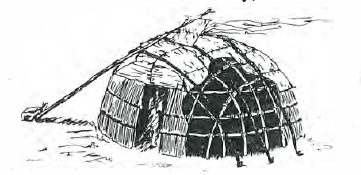The Cree Indians were once known as adventurous hunters and warriors who traversed half of Canada. The acquisition of firearms from Hudson Bay aided in their expansion. A proud people, their women had a widespread reputation for beauty, being well proportioned and with more Caucasian type features.
Caribou, moose, bear, and beaver were highly prized by the Cree hunter. The Cree could trail game and knew the exact time of its passage whether month or hour. From early childhood a Cree was trained to give close attention to every detail in nature. This interest in their surroundings and eagerness to experiment revealed many medical properties of plants. In the winter when there was a scarcity of game the Cree subsisted on hares. These were caught in snares made from willow bark. In the spring geese and ducks returned. Fishing was done by the women as the men considered this beneath them. Women were also gathers of crowberries, cranberries and in times of scarcity, reindeer moss.
The Cree lodge was shaped like a dome. The frame was made of arched willow poles that had both ends secured in the ground. The diameter was 10 to 12 feet and the height was 8 to 10 feet. The covering was either bark or skins.
Customs were numerous among the Cree. They possessed a ceaseless fear of witchcraft There were many taboos and hunting customs. Hunters carried medicine bags to help in the chase. Adolescents went into seclusion and fasted for visions. Old people were abandoned or killed at their request if they could not keep up with the band. Burials were under the ground and there was self-torture in honor of the deceased. The custom of tattooing was universal. Women would have one or two lines drawn from the comers of their mouths towards the angle of their jaws. Some men would cover their bodies with figures depicting acts of heroism of courage. For this they used powdered willow charcoal rubbed into punctures or knife cuts.
Dress varied from season to season. They wore tight leggings, caps, shoes, mittens or robes of moose skin or beaver fur. The leather was always painted or worked with porcupine quills and adorned with tassels or fringe. Women would often wear decorated capes. During the summer they were lightly dressed and in the winter wore oval shaped snowshoes to hunt.
It was a terrible epidemic of smallpox in 1784 and the use of firearms by surrounding tribes that brought the Cree to a halt. Esteem was then lost through the spirituous liquors of the white traders. The Cree again suffered another out break of smallpox in 1838. The tribe was devastated and scattered in different areas of Canada. From this they never recovered and earned a small livelihood by trapping and hunting.
Today the Cree are scattered throughout Canada and are a people who continue with many traditions despite the stress of poverty and loss of land.
Resources:
- Encyclopedia of North American Indians, Houghton & Mifflin
- Catholic Encyclopedia: Cree
